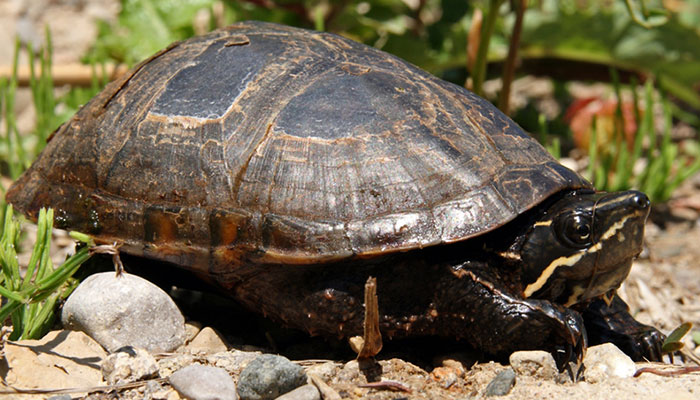
Musk Turtle Caresheet
Introduction
There are a number of different species of Musk Turtles, two species we often have here at Turtle Creek include the Common Musk Turtle (Sternotherus odoratus) and the Razorback Musk Turtle (Sternotherus carinatus). Both these species are native to states across North America such as Texas, Mississippi, Louisiana and Florida. They inhabit slow moving rivers, swamps, lakes and oxbows. The life expectancy for Common and Razorback Musk turtles to around 30 years and they have been known to live up until 50. Both species are quite small, not exceeding 6 inches in length making them ideal turtles for keeping indoors or in aquariums.

Musk Turtle Photo
Habitat and Housing
Hatchling Musk turtles can be kept in a 2-foot-long aquarium. Adults however will require a much larger aquarium of about 4 feet long. The water depth should be at least twice the width of the turtle’s shell, higher if possible. The water temperature should range between 23-26 degrees Celsius. This can be achieved using an aquarium heater. An underwater hiding place should be provided where the turtle can hide but cannot become trapped and drown.
A basking area is crucial, where the turtle can leave the water completely and fully dry off. The basking area’s temperature should be between 30-35 degrees Celsius. This can be provided by fitting a heat lamp to your aquarium. Musk turtles require UVB lighting to survive. UVB provides the turtle with vitamin D3 which then enables the turtle to absorb Calcium from its food. Without Vitamin D3 the turtle will develop metabolic bone disease (MBD) and eventually die. This can be provided by using bulbs which emit UVB which are readily available from any pet shop.
Water quality is very important as the turtles can develop health issues due to inadequate water quality. One way to help ensure good water quality is by using an aquarium or pond filter. External filters are generally more suitable than internal filters as they are larger, and the turtle cannot dislodge the filter causing it to malfunction. Frequent water changes are also necessary to ensure good water quality. Artificial plants, stones and logs should be added to the enclosure to create a more natural look and feel.
Feeding and Diet
Musk turtles are predominately carnivorous. Good foods include; fish, molluscs, snails, worms and insects. Furthermore, there is a wide variety of commercial turtle foods available. Hatchling Musk turtles require higher levels of protein and calcium in their diet then adults. So, it is important to choose the food which has been formulated to provide optimum nutrition for your turtle’s growth stage. There are a number of vitamins and minerals which are crucial to ensure your turtles healthy development and wellbeing, so it is important to choose a turtle food with a wide range of Vitamins and minerals or add them using a multivitamin and calcium supplement.
It is important not to overfeed your turtle as it will have health implications. Overfeeding in turtles has been shown to cause liver problems, shell deformation and shortened lifespan. Hatchlings should be fed every 2nd day while adults should be fed approximately two times every week.
Musk Turtle Health
- Poor water quality can result in your turtle developing skin, shell, and ear infections. Ear infections commonly show up as large bumps behind your turtle's eyes and need to be addressed by your vet.
- Swollen eyes can occur due to a lack of vitamin A in the turtle’s diet. The eyes appear pink and swollen. There are eye drops available but in severe cases a vet should be consulted. The best way to prevent this problem is to provide your turtle with the appropriate diet.
- Metabolic bone disease (MBD) will occur if your turtle isn’t receiving sufficient levels of vitamin D3 and calcium. This will lead to shell deformation, limpness, decreased appetite and if left untreated eventually death. A vet should be consulted if you think your turtle is suffering from MBD.
- Shell Rot can occur if your turtle doesn’t have access to an adequate basking area where it can fully dry off. It causes the shell to literally rot away over time. If left untreated shell rot will gradually get worse. If you think your turtle has shell rot contact your veterinarian.
Sexing and Breeding
Male Musk turtles and females are very similar, especially juveniles. Sexing adult Musk turtles is possible. Males are normally smaller than females and have longer tails that are characterised with a terminal tail spike.
Musk Turtle Mating happens underwater where the male is on top of the female. This will usually take place from April through to May, but it has been reported happening during September. Females will leave the water to lay their clutch up to 3 times. Clutch size varies depending on a number of factors. Larger females lay larger clutches.
